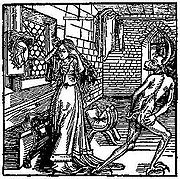
The Book of the Knight in the Tower
Encyclopedia

French language
French is a Romance language spoken as a first language in France, the Romandy region in Switzerland, Wallonia and Brussels in Belgium, Monaco, the regions of Quebec and Acadia in Canada, and by various communities elsewhere. Second-language speakers of French are distributed throughout many parts...
title: Livre pour l'enseignement de ses filles du Chevalier de La Tour Landry) is a book commenced by Geoffroy IV de la Tour Landry
Geoffroy IV de la Tour Landry
Geoffrey IV de la Tour Landry was a nobleman of Anjou who compiled Livre pour l'enseignement de ses filles for the instruction of his daughters, in 1371–1372. A similar book he had previously written for his sons, according to his opening text, has disappeared. The work became the most popular...
in 1371, and which he continued writing at least until 1372. It was translated into English
English language
English is a West Germanic language that arose in the Anglo-Saxon kingdoms of England and spread into what was to become south-east Scotland under the influence of the Anglian medieval kingdom of Northumbria...
(as The Book of the Knight of the Tower) by William Caxton
William Caxton
William Caxton was an English merchant, diplomat, writer and printer. As far as is known, he was the first English person to work as a printer and the first to introduce a printing press into England...
and completed, according to his colophon, on June 1, 1483, during the reign of Richard III
Richard III of England
Richard III was King of England for two years, from 1483 until his death in 1485 during the Battle of Bosworth Field. He was the last king of the House of York and the last of the Plantagenet dynasty...
. It was further translated into German
German language
German is a West Germanic language, related to and classified alongside English and Dutch. With an estimated 90 – 98 million native speakers, German is one of the world's major languages and is the most widely-spoken first language in the European Union....
as Der Ritter vom Turn in 1495. The Livre pour l'enseignement de ses filles served as a tutorial for De la Tour Landry's daughters on proper behavior when visiting the royal court, which, the knight warns, is filled with smooth-talking courtiers who could potentially disgrace them and embarrass the family. The author was a widower, and concerned for his daughters' welfare. He takes a strong moral stance against the behavior of his peers and warns his daughters about the dangers of vanity
Vanity
In conventional parlance, vanity is the excessive belief in one's own abilities or attractiveness to others. Prior to the 14th century it did not have such narcissistic undertones, and merely meant futility. The related term vainglory is now often seen as an archaic synonym for vanity, but...
.
The German Der Ritter vom Turn was the work of Marquard vom Stein, a member of the Swabia
Swabia
Swabia is a cultural, historic and linguistic region in southwestern Germany.-Geography:Like many cultural regions of Europe, Swabia's borders are not clearly defined...
n nobility. He himself had two daughters, Elsa and Jakobea, for whose benefit he claims to have translated the French text. William Caxton
William Caxton
William Caxton was an English merchant, diplomat, writer and printer. As far as is known, he was the first English person to work as a printer and the first to introduce a printing press into England...
printed the English version in 1484.
Another English translation older than Caxton's survives in manuscript; British Library
British Library
The British Library is the national library of the United Kingdom, and is the world's largest library in terms of total number of items. The library is a major research library, holding over 150 million items from every country in the world, in virtually all known languages and in many formats,...
, Harley no. 1764. The manuscript was written in the reign of Henry VI of England
Henry VI of England
Henry VI was King of England from 1422 to 1461 and again from 1470 to 1471, and disputed King of France from 1422 to 1453. Until 1437, his realm was governed by regents. Contemporaneous accounts described him as peaceful and pious, not suited for the violent dynastic civil wars, known as the Wars...
.

